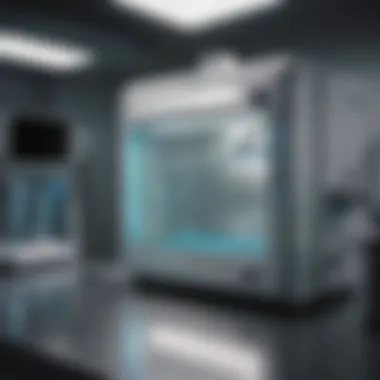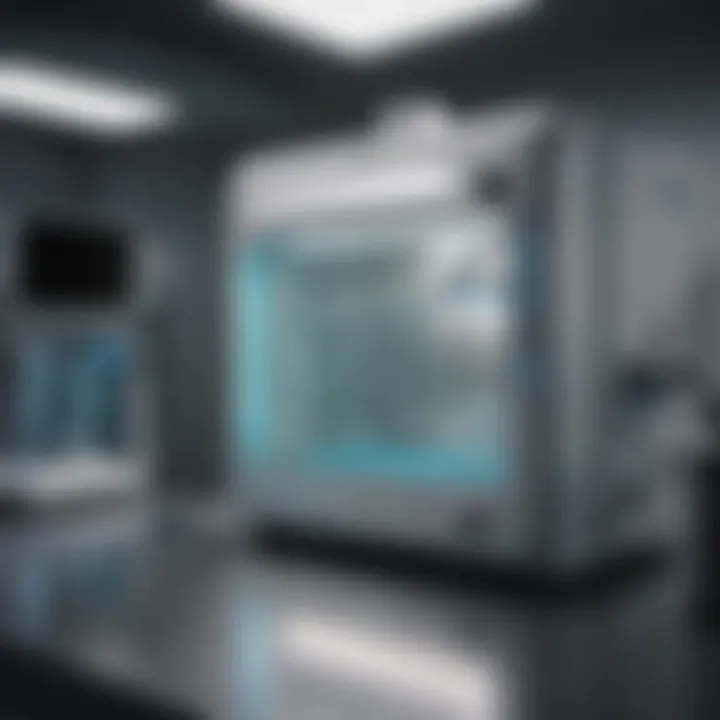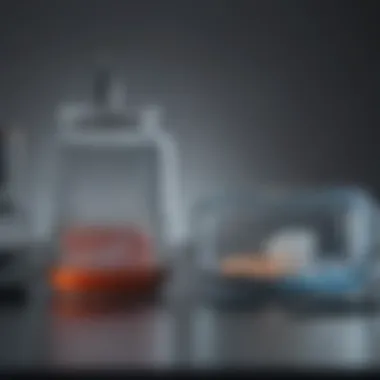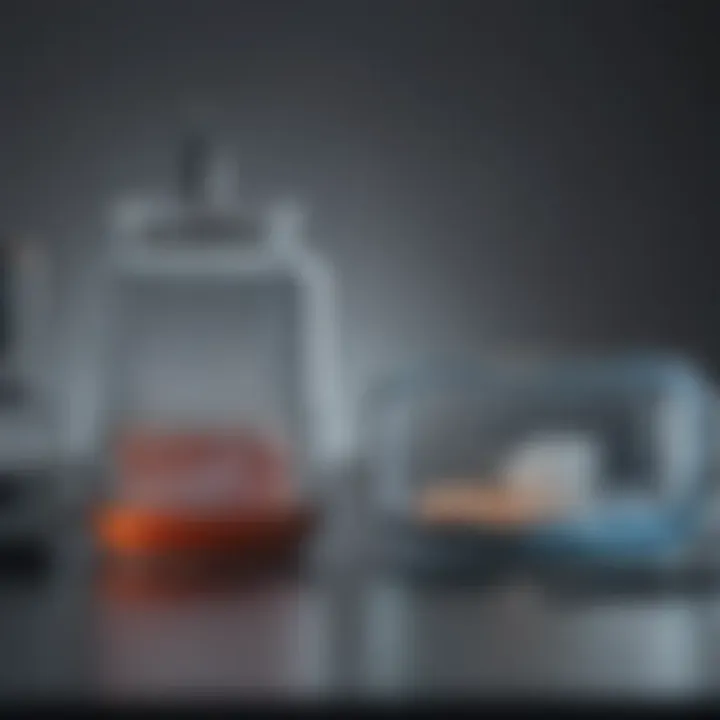UV Sterilization of Surgical Instruments Explained


Intro
In the realm of healthcare, sterilization of surgical instruments remains a crucial practice to ensure patient safety and promote positive outcomes. Ultraviolet (UV) sterilization has emerged as a notable method in this context, leveraging UV light to inactivate pathogens effectively. This article serves as a comprehensive guide, outlining the intricacies of UV sterilization for surgical instruments. It will delve into the efficacy of UV sterilizers, their operational mechanisms, advantages over traditional methods, potential limitations, and the regulatory landscape. Future trends and research directions will also be addressed, providing valuable insights for healthcare professionals and scholars alike.
Preface to UV Sterilization
The advent of UV sterilization represents a significant advancement in the field of medical disinfection, particularly for surgical instruments. The need for reliable sterilization methods is paramount to prevent hospital-acquired infections and ensure patient safety. Surgical instruments come in contact with various biological materials, making their thorough disinfection essential. UV sterilization provides an effective way to eliminate pathogens while being less harmful to the environment compared to traditional methods.
In this section, we will discuss the fundamental concepts of UV light and its applications in healthcare settings. The goal is to establish a clear understanding of how UV sterilization works and its relevance to surgical practices and infection control.
Understanding UV Light
Ultraviolet (UV) light is part of the electromagnetic spectrum, adjacent to visible light but with shorter wavelengths. There are three primary types of UV light: UVA, UVB, and UVC. UVC light, particularly in the range of 200 to 280 nanometers, is most effective for disinfection purposes. This form of UV is particularly effective in disrupting the DNA of microorganisms, rendering them inactive.
The effectiveness of UVC light is determined by several factors:
- Wavelength: The ideal sterilizing wavelengths fall between 200 and 280 nm.
- Exposure Time: Longer exposure increases the likelihood of microbial inactivation.
- Intensity: Higher intensity can result in faster sterilization.
Understanding these parameters is crucial for optimizing UV sterilization protocols in healthcare settings.
Applications of UV Sterilization
UV sterilization finds various applications in healthcare beyond just surgical instruments. Its versatility makes it a valuable tool in different contexts. Some notable applications include:
- Surgical Instrument Disinfection: Effective in neutralizing bacteria and viruses on surgical tools before use.
- Surface Sterilization: Used in operating rooms, examination tables, and other high-touch surfaces to minimize infection risk.
- Air Disinfection: Installed in HVAC systems to purify air in medical facilities, reducing airborne pathogens.
While the benefits are considerable, practitioners must remain aware of the limitations associated with UV sterilization, which we will explore in a later section. By understanding both its applications and limitations, healthcare professionals can implement UV sterilization effectively and safely.
Mechanisms of UV Sterilization
Understanding the mechanisms of UV sterilization is crucial. It is this knowledge that helps healthcare professionals adopt effective strategies for disinfection. UV sterilization relies fundamentally on the properties of UV light to destroy microorganisms, ensuring surgical instruments are safe and free from pathogens.
How UV Light Kills Microorganisms
UV light operates primarily through mechanisms that damage the DNA of microorganisms. When UV light penetrates the cells of bacteria, viruses, and fungi, it induces the formation of thymine dimers. These dimers disrupt the normal base pairing in DNA, preventing replication and transcription. Eventually, this leads to cell death.
The efficiency of UV sterilization depends on several factors. These include the intensity of the UV light, exposure time, and the type of organisms being targeted. For example, some viruses exhibit greater resilience compared to bacteria.
Types of UV Light
Different types of UV light are used for sterilization. Understanding their characteristics can help determine which type is more effective in specific situations.
UVA
UVA rays constitute the longest wavelength among the UV spectrum. They are less effective in killing microorganisms directly. However, they can induce cellular damage indirectly by generating reactive oxygen species. This may weaken the microorganisms over time. Despite this, UVA is often used in applications like promoting photosensitization in certain medical treatments.
- Key Characteristics: Less germicidal than other types.
- Unique Feature: Ability to induce secondary cellular reactions.
- Advantages/Disadvantages: Broad penetration, but less direct killing power.
UVB
UVB rays have shorter wavelengths and are more potent compared to UVA. They can effectively damage DNA in microorganisms. Nevertheless, their penetration power into surfaces is lower. In surgical sterilization, UVB could be more useful in settings where UV light directly targets surfaces.
- Key Characteristics: Medium germicidal ability.
- Unique Feature: Stronger effect on DNA than UVA.
- Advantages/Disadvantages: Effective for surface sterilization, but can require longer exposure times.
UVC
UVC light has the shortest wavelength and is the most effective for sterilization. It can kill a range of pathogens within seconds of exposure. UVC lamps are widely used in medical facilities for sanitizing instruments and surfaces. The main limitation is that UVC light does not penetrate biological materials effectively.


- Key Characteristics: Highest sterilization efficiency.
- Unique Feature: Fast-acting against a broad spectrum of microorganisms.
- Advantages/Disadvantages: Highly effective, but requires precautions to prevent harm to humans.
Benefits of Using UV Sterilizers
The adoption of UV sterilizers in healthcare settings has gained prominence, especially during times when the demand for effective disinfection methods is high. This section delineates the key benefits of utilizing UV sterilizers for surgical instruments, focusing on their operational advantages, effectiveness, and overall impact on patient safety.
Speed and Efficiency
One of the most compelling benefits of UV sterilizers is their speed and efficiency. In contrast to traditional methods, such as steam or chemical sterilization, UV sterilization can effectively disinfect surfaces and tools in a matter of minutes. This quick turnaround is invaluable in healthcare environments where time-sensitive procedures frequently occur. For instance, using UV sterilizers can reduce delays in instrument availability after surgeries. Furthermore, this approach minimizes downtime, allowing medical professionals to maintain a steady workflow.
The efficiency of UV sterilizers also extends to the ease of integration within existing sterilization protocols. They require relatively minimal setup, which facilitates rapid deployment in various healthcare facilities. Moreover, the ability to disinfect multiple instruments simultaneously enhances their productivity, further contributing to operational efficiency.
"UV sterilizers offer a quick, effective alternative to traditional methods, boosting productivity in healthcare settings."
Chemical-Free Disinfection
Another significant advantage of UV sterilization is its chemical-free nature. In an era marked by increasing regulatory scrutiny around chemical usage in healthcare, UV sterilizers present a vital alternative. They eliminate the need for potentially hazardous chemical agents that can leave residues on instruments, challenging both safety and material integrity.
Disinfectants such as hydrogen peroxide or bleach often require specific handling and post-sterilization rinsing to remove any traces. In contrast, UV light operates entirely without these concerns, simplifying the sterilization process. This feature is particularly important for delicate surgical instruments, which may be adversely affected by harsh chemicals over time. The absence of chemical residues reduces the risk of allergic reactions or complications for patients undergoing surgeries.
In summary, the integration of UV sterilizers in surgical settings not only streamlines procedures through speed and efficiency but also addresses critical patient safety concerns by offering a chemical-free solution. This dual benefit makes UV sterilization a desirable component of modern healthcare practices.
Limitations of UV Sterilization
Understanding the limitations of UV sterilization is crucial for comprehensively evaluating its application in surgical instrument disinfection. While UV sterilization presents various benefits, it also has inherent weaknesses that can impact its efficacy and safety. Recognizing these limitations allows healthcare professionals to make informed decisions regarding sterilization methods. This section outlines two significant limitations—surface limitations and human safety considerations.
Surface Limitations
One of the primary drawbacks of UV sterilization is its dependence on direct exposure to ultraviolet light. Unlike steam or chemical methods, UV sterilization relies on line-of-sight exposure to effectively disinfect surfaces. This limitation means that shaded areas on surgical instruments are susceptible to incomplete sterilization. Any obstructions can hinder the UV light from reaching potential contaminants. For complex instruments with intricate designs, shadows may form that leave areas untouched by the UV rays.
Furthermore, some materials can absorb UV light, making them less effective for sterilization. For example, certain plastics or coatings may dim the effectiveness of UV light. Therefore, manufacturers must consider the compatibility of UV sterilization with the materials of the instruments being disinfected. The necessity for thorough cleaning before UV exposure is also essential, as surfaces must be free from organic matter that can shield microorganisms from the UV light.
Human Safety Considerations
Human safety is another significant aspect to consider when implementing UV sterilization in healthcare settings. Exposure to UV light can pose health risks to personnel operating UV sterilizers. Ultraviolet radiation can cause skin burns and eye injuries, including photokeratitis. To mitigate these risks, proper safety protocols must be established.
It is vital to ensure that protective equipment is available and used by staff when UV sterilization is ongoing. Moreover, appropriate safety training should be provided to reduce the chances of accidental exposure. The automatic shut-off feature in certain devices is a good example of technological advancement that can enhance safety. However, reliance on technology alone is not sufficient.
Healthcare departments must prioritize developing comprehensive safety protocols that include warnings, safety signage, and remote operations to minimize direct human contact.
Comparison with Traditional Sterilization Methods
In the sphere of healthcare, sterilization is crucial for ensuring the safety and efficacy of surgical instruments. This section aims to compare UV sterilization with traditional sterilization methods such as steam, chemical, and heat sterilization. Each method has distinct characteristics, advantages, and drawbacks. Understanding these differences is vital for making informed decisions in sterilization protocols.
Steam Sterilization
Steam sterilization, commonly known as autoclaving, is a widely accepted method for sterilizing surgical instruments. It utilizes high-pressure steam to kill microorganisms, including bacteria, viruses, and spores. The process typically involves heating water to generate steam which is then applied under pressure for a specific period.
The primary benefits of steam sterilization include its ability to penetrate complex instruments effectively and the destruction of spores, making it one of the most reliable methods. However, there are limitations; some heat-sensitive materials cannot withstand the high temperatures involved. Moreover, if instruments are not properly cleaned before sterilization, the presence of organic material can compromise the effectiveness of the process.
Chemical Sterilization
Chemical sterilization uses chemical agents to disinfect instruments, which can be particularly useful for items that are sensitive to heat and moisture. Agents like ethylene oxide and hydrogen peroxide are commonly used in this method. Ethylene oxide, for example, works well for complex devices and is often employed in hospitals for delicate instruments that cannot endure high temperatures.
While chemical sterilization is effective, it is not without risks. The chemicals used can be toxic, and there may be lengthy aeration times needed to ensure that residual chemicals do not harm patients.
Heat Sterilization


Heat sterilization can refer to a variety of methods including dry heat and moist heat. Dry heat sterilization, for instance, is slower and less effective than steam sterilization. It is typically used for materials that are moisture-sensitive. The process may require prolonged exposure at high temperatures. Like steam sterilization, heat sterilization effectively kills most microorganisms, but, again, the drawback is its limited applicability to heat-sensitive instruments.
"Effective sterilization methods are an essential component in preventing healthcare-associated infections and ensuring patient safety."
Choosing the most appropriate sterilization method involves carefully considering the types of instruments being used and the efficacy of the chosen method.
Regulatory Standards and Guidelines
In the field of surgical instrument sterilization, adherence to regulatory standards and guidelines is critical. These protocols ensure that sterilization methods, including UV sterilization, maintain high levels of efficacy and safety. Regulatory bodies like the Centers for Disease Control and Prevention (CDC) and the Food and Drug Administration (FDA) play significant roles in shaping these standards. Their recommendations promote best practices and help mitigate risks associated with infection transmission in healthcare settings.
Recommendations
The CDC provides guidance on infection control and sterilization practices. Their recommendations are based on extensive research and aim to protect both healthcare workers and patients. One of the key points made by the CDC is the importance of using validated sterilization methods. For UV sterilization, this includes ensuring the equipment is properly calibrated and maintained. The CDC emphasizes that healthcare facilities must establish protocols for monitoring the performance of UV sterilizers. Regular checks can help confirm that the required dosage of UV light reaches all surfaces of the instruments being sterilized. Additionally, the guidelines suggest incorporating UV sterilization as part of a comprehensive infection control strategy rather than as a standalone method.
Key Aspects of Recommendations:
- Verifying calibration and maintenance of UV sterilizers
- Regular monitoring of sterilization performance
- Integrating UV sterilization with other sterilization methods
FDA Regulations
The FDA regulates the use of medical devices, including UV sterilization equipment. Their regulations ensure that any devices used in healthcare settings meet safety and efficacy standards. Manufacturers of UV sterilizers must submit data demonstrating that their products can effectively reduce or eliminate pathogens. The FDA also requires labeling that provides instructions for proper use, maintenance, and safety considerations. For example, the labeling should inform users about potential risks related to UV exposure to human skin.
The FDA's role is crucial in ensuring that UV sterilizers are not only effective but also safe for use in medical environments.
Important Elements of FDA Regulations:
- Submission of safety and efficacy data by manufacturers
- Clear labeling with usage instructions and safety warnings
- Ongoing monitoring of product performance post-market
Understanding and implementing these regulatory standards is essential for healthcare professionals. Compliance with CDC recommendations and FDA regulations enhances the safety and effectiveness of UV sterilization practices. As such, following these guidelines not only supports infection control measures but also fosters confidence in the use of technology in patient care.
Technological Advances in UV Sterilization
Advancements in technology have significantly impacted UV sterilization, particularly in healthcare. This section highlights the importance of innovative devices and automation, as these developments enhance the efficacy and convenience of using UV sterilizers for surgical instruments.
Innovative UV Devices
Recent developments in UV technology have led to the creation of more effective and user-friendly sterilization devices. One noteworthy example is the introduction of handheld UV-C devices, which have become popular due to their portability and ease of use. These devices enable healthcare professionals to sterilize instruments quickly and efficiently without needing complex setups.
Additionally, there are fixed UV sterilization units that deploy advanced reflective technology. This technology boosts the UV light's intensity, ensuring a more thorough disinfection process. These innovations not only improve the sanitization levels but also reduce the time needed for the processes, allowing for faster turnaround in surgical environments.
Some innovative designs now feature automated sensors that adjust the exposure time based on the type of instrument being sterilized. This customization is instrumental in maximizing effectiveness while minimizing potential errors during the disinfection process.
In summary, the development of these innovative devices enhances the capacity of UV sterilizers to meet modern healthcare demands while ensuring high standards of safety and efficacy.
Integration with Automated Systems
The integration of UV sterilization technologies with automated systems is another advancement that has transformed healthcare practices. Automated systems can help streamline the sterilization process, reducing the risk of human error. One significant benefit of this integration is the improved consistency in sterilization outcomes.
For instance, many healthcare facilities now utilize UV sterilization robots that navigate surgical rooms and sterilize instruments autonomously. These robots can be programmed to perform multiple tasks, making them versatile and efficient. They operate following a set protocol based on clinical guidelines, ensuring that no step is missed during the disinfection process.
Moreover, some automated systems include monitoring features that provide real-time data on UV exposure levels, allowing for adjustments if necessary. This integration can significantly reduce downtime between procedures, optimizing the workflow in surgical environments.
The automated aspect of UV sterilization not only enhances efficiency but also underscores a commitment to safety. By minimizing manual intervention, the potential for contamination and adverse events is lowered. As a result, healthcare facilities utilizing automated UV sterilization systems can boost their overall safety and effectiveness in infection control.
Future Trends in Sterilization Technologies
The landscape of sterilization technologies is continually evolving, driven by innovations and the need for safer, more effective disinfection methods. As healthcare practices strive for higher standards in hygiene, UV sterilization has gained attention for its potential to complement or even replace traditional sterilization methods. This section delves into emerging research areas and enhancements that could make UV sterilizers more effective and reliable in surgical settings.


Emerging Research Areas
Recent studies focus on various aspects of UV sterilization to enhance its application in healthcare. The following areas have garnered attention:
- Broad-Spectrum Efficacy: Investigating the effectiveness of UV light against a broader range of pathogens, including bacteria, viruses, and fungi. This research aims to determine how varied wavelengths can optimize disinfection.
- Nanotechnology Integration: The combination of UV light with nanoparticles is an exciting avenue. Nanotechnology could improve the efficiency of UV sterilization by using materials that enhance light absorption or facilitate better distribution of UV light over surfaces.
- Microbial Resistance: Studies are exploring how microorganisms adapt to UV light exposure. Understanding microbial resistance is critical to develop strategies that enhance the effectiveness of UV sterilizers over time.
- Real-Time Monitoring: Innovations in sensors and monitoring technologies could allow real-time assessments of UV system performance. This advancement would help ensure that sterilization processes are both reliable and efficient.
Engagement in these research areas will likely lead to significant advancements in sterilization protocols, making UV sterilizers even more critical in maintaining sterile environments.
Potential Improvements in UV Efficacy
Enhancing the efficacy of UV sterilizers involves several strategies that researchers are pursuing:
- Optimizing Wavelengths: Research is ongoing to find the most effective wavelengths for disinfection. Current focus is mainly on UVC light, which is known for its germicidal properties. However, such studies aim to determine if other wavelengths might also result in improved sterilization outcomes.
- Increased Exposure Time: Prolonged exposure to UV light is bound to enhance disinfection effectiveness. Researchers are investigating optimal exposure durations depending on the type and quantity of microorganisms present.
- Surface Geometry Analysis: Analyzing the effects of surface shapes and materials on UV light penetration could enhance efficacy. More efficient designs for surgical instruments may lead to better sterilization results.
- Combination Treatments: Exploring the use of UV light alongside other disinfection methods, like chemical agents or steam, may yield synergistic effects that boost overall sterilization success.
"Future advancements in UV sterilization are not merely about efficiency but also about understanding how to maximize the potential of light for healthcare safety."
These improvements not only increase the effectiveness of UV sterilizers but also may expand their applications beyond surgery to other clinical settings, reinforcing their value in healthcare.
Practical Considerations for Implementing UV Sterilization
UV sterilization is an emerging technology in the realm of disinfection, particularly in healthcare settings. It offers a promising alternative to traditional sterilization methods. However, the application of this technique requires careful consideration of various practical elements.
Implementing UV sterilization effectively involves understanding space requirements and equipment specifications. Equally important is ensuring that personnel are trained adequately to operate these devices. These factors play a critical role in achieving optimal outcomes and maintaining safety standards in a clinical environment.
Space and Equipment Requirements
The spatial requirements for UV sterilization systems can vary significantly based on the technology used and the volume of surgical instruments that need disinfection. A dedicated area with appropriate UV fixtures is necessary to ensure proper exposure to UV light. If the equipment is not located in a controlled environment, barriers like walls or other furnishings could block UV rays, reducing efficacy.
Essentially, space should allow for:
- Safe placement of UV sterilizers beyond reach of patients and untrained personnel to prevent unnecessary exposure.
- Adequate airflow to prevent heat accumulation, which can affect the performance of the systems.
- Easy access for health professionals to load and unload instruments without risk of contamination.
Furthermore, the equipment needs to meet quality standards dictated by industry regulations. The design of UV devices, such as the wavelength emission, should be effective against various pathogens. Consideration of maintenance needs is also crucial. Regular checks and replacements for bulbs are necessary to ensure the UV sterilizers function at their best.
Training and Personnel Competence
Proper training and competence among personnel is non-negotiable when it comes to the implementation of UV sterilization. Staff must understand not only how to operate the sterilizers, but also the underlying principles of UV sterilization. This includes knowing:
- The correct operating procedures to maximize the effectiveness of the machines.
- Safety protocols to prevent direct exposure to UV light, which can be harmful to skin and eyes.
- The importance of monitoring and logging sterilization cycles to ensure compliance with sterilization standards.
Training should also encompass troubleshooting aspects. Employees need to be equipped to handle minor technical issues or recognize when professional repairs are necessary. This competency ensures that sterilization processes do not fall behind and that surgical instruments are available when needed.
In summary, effective UV sterilization is as much about technology as it is about training and practical implementation. By ensuring appropriate space and precise training, healthcare facilities can enhance their disinfection processes significantly.
“An effective sterilization system hinges on both technical setup and human expertise.”
Effective integration of UV sterilization practices will optimize the disinfection process and uphold the standards in surgical settings. The investment of time and resources in these practical considerations will yield high returns in patient safety and operational efficiency.
Closure
In the context of surgical instrument disinfection, understanding the implications and efficacy of UV sterilizers is essential. This article highlights the significant role that UV sterilization plays in safely and effectively eradicating pathogens. The findings presented illustrate not just the advantages but also the limitations associated with this technology. Recognizing these factors is crucial for healthcare professionals who seek to maintain high standards of sterilization in their practices.
Summary of Findings
This analysis has illuminated several key points regarding UV sterilization. Firstly, the mechanism by which UV light targets and destroys microorganisms is foundational to its effectiveness. The ability of UVC light to disrupt the DNA or RNA of harmful pathogens ensures a reliable method for disinfection. Additionally, the benefits of using UV sterilizers are notable, particularly in their speed and chemical-free operation. These advantages can greatly enhance the efficiency of sterilization processes in surgical settings.
Despite these benefits, there remain limitations to UV sterilization. The technology is primarily effective on surfaces that are directly exposed to UV light. Moreover, human safety considerations cannot be overlooked, as UV exposure poses risks to skin and eyes. Therefore, protocols must be in place to mitigate these risks while maximizing UV sterilization's advantages.
Final Thoughts on UV Sterilizers
The evolving landscape of sterilization technologies is marked by continual advancements and increased regulatory scrutiny. As healthcare increasingly adopts UV sterilizers, staying informed about the latest studies and industry standards becomes paramount. These sterilizers offer a modern approach to disinfection, aligning with the growing need for safe and effective methods in healthcare environments. To ensure successful implementation, healthcare practitioners must remain aware of their operational protocols and the specific contexts in which UV sterilizers can be most beneficial.
In summary, while UV sterilizers present a compelling option for surgical instrument disinfection, achieving their full potential requires thoughtful integration into existing sterilization frameworks. It is essential for those in the healthcare field to actively engage with emerging research and best practices to continuously improve sterilization outcomes.



